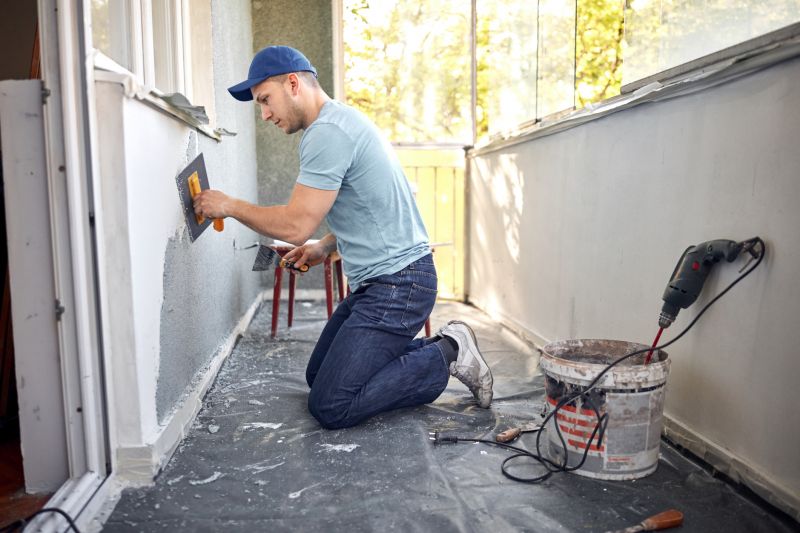Top-Rated Products for Fixing Spalling Concrete Damage Easily
Identify high-performance repair products that simplify the process of fixing spalling and restore concrete integrity.
 Spalling concrete is a common issue that occurs when the surface of concrete begins to flake, chip, or peel away, often due to exposure to moisture, freeze-thaw cycles, or poor initial application. Addressing spalling effectively requires selecting the right repair products to restore the integrity and appearance of the concrete surface. A variety of products are available to suit different repair needs, ranging from patching compounds to sealers and bonding agents. Proper selection and application of these materials can help extend the lifespan of concrete structures and improve their safety and aesthetics.
Spalling concrete is a common issue that occurs when the surface of concrete begins to flake, chip, or peel away, often due to exposure to moisture, freeze-thaw cycles, or poor initial application. Addressing spalling effectively requires selecting the right repair products to restore the integrity and appearance of the concrete surface. A variety of products are available to suit different repair needs, ranging from patching compounds to sealers and bonding agents. Proper selection and application of these materials can help extend the lifespan of concrete structures and improve their safety and aesthetics.
Top Overall Option
High-Performance Concrete Patch Compound
A versatile and durable patching compound designed for repairing spalled and damaged concrete surfaces. It offers excellent adhesion, workability, and resistance to environmental factors, making it suitable for a variety of repair scenarios. When applied correctly, it can help restore the integrity of concrete surfaces effectively and efficiently.
Types of Products For Spalling Concrete Repairs
Polymer-Modified Concrete Patches
Flexible patching compounds that bond well with existing concrete and accommodate slight movements, ideal for surface spalling repairs.
Epoxy Resin Repair Kits
High-strength epoxy formulations used to fill deeper cracks and restore structural integrity in damaged concrete areas.
Hydraulic Cement Mixes
Quick-setting cement-based products suitable for emergency repairs and filling larger spalled sections.
Bonding Adhesives
Specialized adhesives that promote strong bonds between old and new concrete layers during repairs.
Surface Sealers and Protectors
Sealants designed to prevent water infiltration and future spalling by providing a protective barrier.
Crack Fillers
Flexible fillers formulated to fill and seal surface cracks to prevent further deterioration.
Polyurethane Foam Injectors
Expandable foam used to fill voids and stabilize spalled areas beneath the surface.
Fiber-Reinforced Repair Mortars
Mortars reinforced with fibers to improve crack resistance and durability in repaired areas.
Waterproofing Membranes
Membranes applied over repaired surfaces to enhance water resistance and reduce future spalling risks.
Self-Leveling Underlayments
Materials used to create a smooth, level surface before finishing or overlaying repairs.
Popular Choices
All-in-one kits containing patch compounds, primers, and sealers suitable for various spalling repair needs.
Quick-curing cement products favored for emergency repairs and quick fixes.
Versatile epoxy systems used for filling cracks and bonding damaged concrete sections.
Sealants that provide a flexible barrier against water ingress and future spalling.
Popular for their ease of use and flexibility in sealing surface cracks.
Resilient mortars suitable for larger repairs and restoring structural integrity.
Commonly used to protect repaired surfaces from water damage and future spalling.
Popular for filling voids beneath spalled surfaces and stabilizing damaged areas.
Widely used due to their enhanced durability and crack resistance.
Products applied to existing concrete to increase surface hardness and reduce spalling.
When considering repair products, it is important to understand the specific conditions causing the spalling. For instance, surface patches may be suitable for minor spalling, while deeper repairs might require specialized bonding agents or epoxy resins. Surface preparation is a critical step, often involving cleaning, removing loose material, and sometimes etching or priming to ensure proper adhesion. Many products are designed to work together, allowing for a comprehensive repair process that addresses both surface and structural concerns.
Durability and compatibility with existing concrete are key factors to consider when choosing repair products. Some products are formulated to withstand harsh weather conditions, while others focus on quick curing times for faster repairs. It is also beneficial to select products that offer good adhesion, flexibility, and resistance to future cracking or spalling. Proper application according to manufacturer instructions will maximize the effectiveness of these products, helping to prevent recurring issues and maintain the long-term stability of the concrete surface.
Key Buying Considerations
- Compatibility with existing concrete surface and environmental conditions
- Type of spalling or damage severity to determine suitable repair product
- Application method and ease of use for your skill level
- Curing time and whether quick repairs are needed
- Adhesion strength to ensure long-lasting repairs
- Flexibility of the product to accommodate minor movements or cracks
- Resistance to water, chemicals, and temperature fluctuations
- Compatibility with other repair materials or sealants being used
- Durability and lifespan expectations based on the repair environment
- Availability of the product and ease of sourcing additional supplies
- Cost-effectiveness considering the scope of the repair
- Manufacturer instructions and recommended surface preparation steps
- Safety and handling requirements during application
- Post-application maintenance or sealing needs
